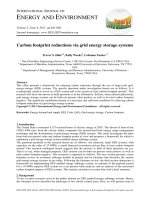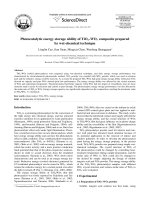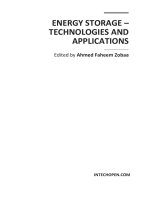Carbon footprint reductions via grid energy storage systems
Bạn đang xem bản rút gọn của tài liệu. Xem và tải ngay bản đầy đủ của tài liệu tại đây (349.62 KB, 6 trang )
I
NTERNATIONAL
J
OURNAL OF
E
NERGY AND
E
NVIRONMENT
Volume 2, Issue 4, 2011 pp.641-646
Journal homepage: www.IJEE.IEEFoundation.org
ISSN 2076-2895 (Print), ISSN 2076-2909 (Online) ©2011 International Energy & Environment Foundation. All rights reserved.
Carbon footprint reductions via grid energy storage systems
Trevor S. Hale
1,3
, Kelly Weeks
2
, Coleman Tucker
3
1
Naval Facilities Engineering Service Center, 1100 23rd Avenue. Port Hueneme, CA 93043 USA.
2
Department of Maritime Administration, Texas A&M University at Galveston, Galveston, TX 77553
USA.
3
Department of Management, Marketing, and Business Administration, University of Houston –
Downtown, Houston, Texas 77002 USA.
Abstract
This effort presents a framework for reducing carbon emissions through the use of large-scale grid-
energy-storage (GES) systems. The specific questions under investigation herein are as follows: Is it
economically sound to invest in a GES system and is the system at least carbon footprint neutral? This
research will show the answer to both questions is in the affirmative. Scilicet, when utilized judiciously,
grid energy storage systems can be both net present value positive as well as be total carbon footprint
negative. The significant contribution herein is a necessary and sufficient condition for achieving carbon
footprint reductions via grid energy storage systems.
Copyright © 2011 International Energy and Environment Foundation - All rights reserved.
Keywords: Energy demand and supply (JEL Code: Q41); Grid energy storage; Carbon footprint.
1. Introduction
The United States consumed 4,157 terawatt-hours of electric energy in 2007. The advent of time-of-use
(TOU) kWh rates from the electric utility companies has incentivized both energy usage management
techniques and the development of grid-energy-storage (GES) systems. This study investigates the latter
from both net present value and carbon footprint points of view and proposes a framework for which to
implement a grid energy storage system enabled energy arbitrage system.
The questions pertinent to the research herein are as follows: Are relatively small GES systems, with
capacities on the order of 25 MWh, a sound financial investment and are they at least carbon footprint
neutral? Our research catalogued herein suggests that the answers to both of these questions are yes.
That is to say, when managed properly, GES systems can be both net present value positive as well as
total carbon footprint negative. This research is organized as follows. The next section presents a terse
literature review on economic arbitrage models in general and on literature that describes the various
grid-energy-storage systems in use today. Following the literature review, the third section demarcates a
framework for implementing GES enabled energy arbitrage system, an estimate of the payback period
for a 10 MWh capacity GES system via a net present value analysis, and an analysis of the associated
carbon footprint impacts of GES systems. This treatise concludes in section four with a brief summary.
2. Background
To wit, no prior research exists in the public domain on GES enabled energy arbitrage systems. Hence,
this literature review describes the landscape of two closely related areas. First, we will present some of
International Journal of Energy and Environment (IJEE), Volume 2, Issue 4, 2011, pp.641-646
ISSN 2076-2895 (Print), ISSN 2076-2909 (Online) ©2011 International Energy & Environment Foundation. All rights reserved.
642
the relevant research on economic arbitrage in general and then, second, literature that describes grid-
energy-storage systems currently in use today. Indeed, it was this void in the literature describing GES
systems that spawned this research project in the first place.
2.1 Economic arbitrage
In frictional economies, the price functions are generally sub-linear and thus there will be incentives to
innovate [1]. This is definitely the case in point regarding energy industry. As consumer prices continue
to rise, people will look for alternatives methods to ease budgetary constraints. The economic aspects of
energy arbitrage play a vital role in offering solutions to this quandary.
The best-known type of economic arbitrage is the exploitation of cheap labor [2]. Energy creation
facilities are generally low labor intensive industries once they are established. This is particularly true of
green energy collection methods such as solar and wind, which also help reduce carbon footprints.
Not all technology for energy arbitrage requires new, innovative technologies. Compressed air energy
storage (CAES) is a technology that is almost 50 years old. The technology, which involves storing off-
peak-generated energy in the potential form of compressed air, is being researched for its use as a load
leveling management tool as well as its capability to function as a stand-alone intermediate generation
source for capturing energy arbitrage, capacity payments, and ancillary services.
Unlike markets for storable commodities, electricity markets depend on the real-time balance of supply
and demand [3]. Therefore, since demand fluctuations vary greatly due to seasonality this makes
forecasting modeling essential. Also, supply can potentially be seasonal, since inclement weather may
not yield sufficient levels of electricity to meet demand.
Walawalkar et al. [3] also determined that there is a strong economic case for installations in the New
York City region for applications such as energy arbitrage. So, it is reasonable to assume an investment
in such systems would be economically beneficial in other geographic regions.
A study done by Matteucci and Reverberi [4] confirmed a non-linear relationship between
technology/market conditions and the first-mover's pricing strategy. So, newer technologies for energy
arbitrage may prove to be less cost effective, until such time the technology is in less demand and costs
have declined. Furthermore, the authors recommend that regulation provide manufacturers with adequate
countervailing incentives to realize the long-term gains from such energy arbitrage systems.
2.2 Grid energy storage systems
Grid energy storage systems have recently been cited in the Wall Street Journal as one of the next great
energy challenges. Despite this, and to wit, there are very few archival quality sources dealing with grid
energy storage systems. Herein, we present the few manuscripts that were found in the open literature
and try to describe the landscape for grid energy storage systems.
Grid-energy-storage systems come in an array of operating mechanisms. With the notable exception of
flow battery, battery, and supercapacitor based systems (see, Gyuk, Kulkarni, Sayer, Boyes, Corey, and
Peek [5] for a description of battery and supercapacitor systems in use today and see Divya and
Østergaard [6] for a more technical analysis on battery based storage systems), that store energy in
electrical form, per se, most GESs utilize some other potential energy as the energy storage medium.
The more notable GES systems in use today include pumped storage hydroelectric (PSHE), compressed
air energy storage (CAES) [7], thermal systems in general, and battery based systems. PSHEs are the
most common (approximately 30 in the United States) GESs and are mostly used by the utility
companies. To operate effectively, PSHEs need two nearby lakes at different elevations in which water is
moved between dependent on the energy demand profiles. Some PSHEs have two sets of pipes (also
known as penstocks): one set for pumping water up to the higher lake and one set for flowing water
down through the turbines. Some PSHEs have just one set of penstocks in which water flows, albeit with
less efficiency, in both directions depending on need. An advantage for the former system is that the
system can do both processes simultaneously. This is especially important if the PSHE derives some of
the energy for the pumps from intermittent sources such as, say, wind and or solar. The downside is that
these systems require more initial investment and more maintenance annually.
3. System models
The current energy delivery system delineated in Figure 1 below is antiquated. The model is a linear
system of energy delivered from the power company to the grid and, in turn, distributed to the demand.
Meters are uni-directional. Demand management is non-existent.
International Journal of Energy and Environment (IJEE), Volume 2, Issue 4, 2011, pp.641-646
ISSN 2076-2895 (Print), ISSN 2076-2909 (Online) ©2011 International Energy & Environment Foundation. All rights reserved.
643
Figure 1. The current energy management system
3.1 Framework
A conceptual framework for the proposed system is depicted in Figure 2 below. Notice that in the
proposed model, the “busiest” node (i.e., the node with the highest degree) in terms of both
communication flows and energy flows is the advanced meter. This is the hub of the system. Energy and
communications flow into and out of the meter in multiple directions. Energy flows in two directions
(depicted with double lightning bolts in Figure 2 between the GES and the advanced meter, it flows in
one direction (depicted with a single bolt in Figure 2) from the advanced meter to the energy sinks in the
house/facility, and it flows in two directions between the GES and the smart energy grid.
The advanced meter is bi-directional, granular per circuit (energy flows are measured per circuit breaker
switch) energy usage/delivery measurement system. Two way communications (depicted with two way
arrows in Figure 2) are integrated between the GES and the electric company as well as in two directions
between the GES and the end-user.
The end-user interfaces with an energy usage management system that includes a GES. The GES stores
low-demand, low-cost energy from off-peak hours until the next afternoon when rates are higher. This is
known in the business both as energy arbitrage and load leveling. It involves transforming electrical
energy into potential energy in the middle of the night when demands are low, storing that as potential
energy, and then transforming it back into electrical energy the next afternoon when rates and demands
are high. However, energy is lost during the two energy conversion processes and, to a lesser degree,
during storage. This loss is expressed as a ratio of energy delivered in the afternoon from the GES over
energy used to provide the energy delivered and it is known as the system’s efficiency.
Energy arbitrage (sometimes known as energy load leveling) is already done on a wide-scale basis by
electric utility companies with massive grid-energy-systems capable of storing several gigawatt-hours of
energy. For example, there are about 30 pump storage hydro electric (PSHE) facilities in the United
States alone ranging from 0.031 to 2.71 gigawatt nameplate capacity. As outlined in section 2, PSHEs
store energy in potential form by pumping water up an elevation in the middle of the night and then let
this same water flow back down via gravity through large turbines.
The enormous start-up price tag of such GES systems as well as non-existent energy policies has always
acted as a barrier to the market. Recent changes in laws (e.g., the Energy Policy Act of 2005 [8] in the
United States) have lessened the policy barrier. However, the start-up cost barriers have remained.
Indeed, electric utility companies have been officially recognized as natural monopolies for over a
century [9]. New and emerging technologies such as flywheels that integrate high temperature,
superconducting magnet systems into the hub chassis, high capacity lithium-ion batteries, and small
scale, ultra high pressure compressed air systems would enable a GES system to function efficiently.
3.2 Net present value analysis
Coupling a 6 million dollar GES system with energy arbitrage via time-of-use (TOU) rates can provide
positive net present values of the associated cash flows in approximately 14.23 years at a 3% discount
rate and approximately 12.28 years employing a 6% discount rate. Table 1, below shows the average of
100 Monte Carlo simulations runs for discounted payback of various GES investment amounts from 1
million to 9 million dollars for a variety of discount rates. This provides some validation for the potential
cost savings involved in such systems.
International Journal of Energy and Environment (IJEE), Volume 2, Issue 4, 2011, pp.641-646
ISSN 2076-2895 (Print), ISSN 2076-2909 (Online) ©2011 International Energy & Environment Foundation. All rights reserved.
644
Figure 2. The proposed integrated GES enabled energy arbitrage conceptual framework
Table 1. Discounted Payback of GES System Investment in Years
Discounted Payback in Years with an Annual Cost Savings of: 344,260
INV ||| RATE
1% 2% 3% 4% 5% 6% 7% 8%
-1,000,000 2.878 2.852 2.827 2.803 2.780 2.757 2.736 2.715
-2,000,000 5.675 5.551 5.435 5.328 5.227 5.132 5.043 4.960
-3,000,000 8.397 8.113 7.857 7.625 7.413 7.218 7.039 6.873
-4,000,000 11.047 10.552 10.117 9.732 9.388 9.078 8.797 8.540
-5,000,000 13.629 12.878 12.235 11.678 11.189 10.755 10.367 10.018
-6,000,000 16.146 15.101 14.229 13.486 12.845 12.284 11.787 11.345
-7,000,000 18.602 17.231 16.111 15.175 14.377 13.687 13.083 12.548
-8,000,000 20.999 19.275 17.895 16.758 15.802 14.984 14.273 13.650
-9,000,000 23.341 21.239 19.589 18.249 17.135 16.190 15.375 14.665
Indeed, from a financial standpoint the question of why one would invest in a grid energy storage system
is better expressed in terms of why one wouldn’t invest.
3.3 Carbon footprint analysis
At first blush, it would seem that due to their inherent energy loss, GES systems might actually emit
more kilograms of carbon dioxide and carbon dioxide equivalents into the atmosphere than an energy
system that simply met the demand at the time-of-use. This is a reasonable concern. That is to say,
strictly in terms of percentages, a 1600 MWh demand placed on a grid-energy-storage arbitrage system
with an efficiency of, say, 0.80 would actually need to expend enough fuel to provide for a 2000 MWh
demand.
International Journal of Energy and Environment (IJEE), Volume 2, Issue 4, 2011, pp.641-646
ISSN 2076-2895 (Print), ISSN 2076-2909 (Online) ©2011 International Energy & Environment Foundation. All rights reserved.
645
However, upon closer inspection, a properly designed and managed GES system uses energy from the
middle of the night. As shown in Figure 3 below, the energy sources in the middle of the night are far
less polluting than in the middle of the afternoon. Renewable sources, although currently provide just 7%
of the total energy source make-up in the United States (conversely, Norway’s hydroelectric generation
meets 98.25% of Norway’s total demand), because of the relatively constant production levels of
renewable over the course of the day, they provide a larger percentage of the total sources in the middle
of the night than they do in the middle of the day. Hence, buying electric energy at night, storing it, and
then using it the next afternoon is ostensibly a smaller net carbon footprint process than buying electric
energy in the afternoon and using it immediately.
Figure 3. 24-hour CO2 equivalent emission profile versus 24-hour energy load profile
Additionally, fossil fuel burning electrical energy production systems known as “peakers” only operate
in the middle of the afternoon to meet the high part (aka, the peaks) of the load profile. These systems
produce more greenhouse gases per kWh than more stable, relatively constant load, twenty-four hour-a-
day fossil fuel burning systems. To wit, reliable per hour-of-day energy source data isn’t available
publicly. However, some aggregate data sources (mostly from studies on the imminent infrastructure
effects of plug-in hybrid electric vehicles) are available to support this argument.
3.4 Carbon footprint reduction
Combining the above theoretical analysis into a formula, we find carbon footprint neutrality of grid
energy storage systems key on the efficiency,
η
, of the particular system as well as the ratio of fossil fuel
content between the off-peak and on-peak loads. The inequality in formula 1 below shows when a
particular grid energy storage system would actually reduce overall carbon footprint.
⎟
⎟
⎠
⎞
⎜
⎜
⎝
⎛
≥
use of timeactualat percentage sourceenergy fuel Fossil
storage of at time percentage sourceenergy fuel Fossil
GES
η
(1)
The limiting factor here is, of course, if the energy bought and stored during off-peak hours completely
eliminates the peaks and valleys of the load profile altogether. This scenario isn’t expected to happen
anytime soon.









